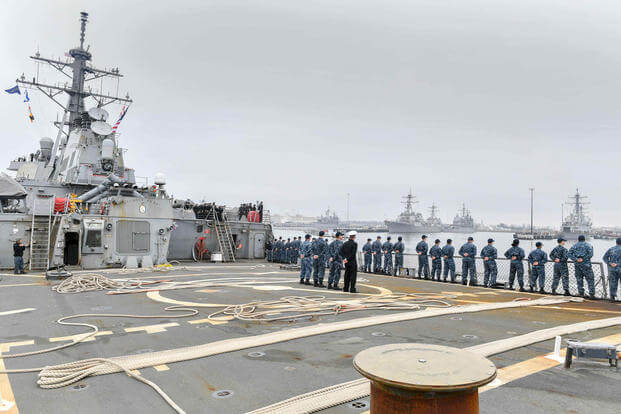The guided-missile destroyer Laboon’s intercept of a small ship on the Arabian Sea March 13 yielded an unexpected bounty: 270 kilograms, or nearly 600 pounds, of smuggled heroin.
The Laboon, part of the George H.W. Bush carrier strike group that deployed from Norfolk, Virginia, in January, had been conducting maritime security operations in the region, according to a release from U.S. Naval Forces Central Command.
As part of Combined Task Force 150, the Laboon had stopped the dhow, or small sailing ship, to verify its nation of origin in what’s called a flag verification boarding. The vessel, officials said, was stateless. During the course of the search that followed, the illicit heroin was discovered.
It was the Laboon’s first drug seizure since the start of its deployment, and the first such interdiction by a Navy ship working under CTF 150 since May 2014, NAVCENT officials said.
For the task force, though, it was the second major drug seizure in less than two weeks. In another major success, the Royal Australian Navy frigate Arunta had seized more than 1,700 pounds of hashish, worth an estimated $36 million, in a March 2 intercept in the region.
"The impressive work of Combined Task Force 150, under the leadership of Royal Canadian Navy Commodore Haydn Edmundson, continued last night with the second successful seizure of illegal drugs in less than two weeks," Vice. Adm. Kevin Donegan, Commander of U.S. Naval Forces Central Command, said in a statement.
"The March 2 seizure by HMAS Arunta and last night's seizure by USS Laboon has resulted in preventing more than a thousand kilograms of combined hashish and heroin from reaching their destination and will prevent transnational terrorists from profiting off these nefarious activities," he said.
The maritime task force, first established in 2002, is one of three designed to promote security and counter terrorist acts and other illegal activities. With collaboration from a number of international allies, CTF 150 has seized and destroyed billions of dollars in drugs and captured thousands of weapons in its 15 years of existence, officials said in the release.
“This is a big win for the coalition,” the commander of CTF 150, Commodore Haydn C. Edmundson from the Royal Canadian Navy, said in a statement. "We in the CTF 150 headquarters are very impressed with the superb cooperation of all units and organizations involved in this successful operation and we are particularly proud of the captain and crew of USS Laboon for their excellent performance on this important mission."
The lead ship of the carrier strike group, the George H.W. Bush, has been conducting airstrikes on Islamic State targets from the Mediterranean Sea since mid-February. Other ships in the CSG include the destroyer Truxton and the guided-missile cruisers Philippine Sea and Hue City.
-- Hope Hodge Seck can be reached at hope.seck@military.com. Follow her on Twitter at @HopeSeck.




























